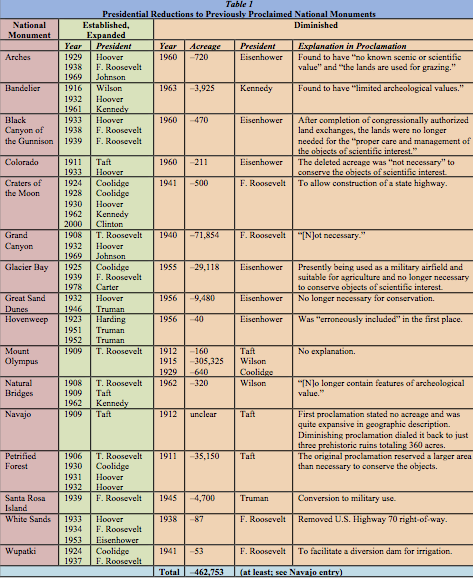The Trump administration is moving ahead with its intention to review and rescind national monument designations for some public lands. Now a leaked memorandum from Secretary of the Interior Ryan Zinke shows that he will be pointing to unproclamations of portions of national monuments by previous presidents as precedent. In this 12-page analysis, we take a closer look here at such precedents and also suggest the illegality of presidents abolishing, diminishing and/or weakening national monuments.
The Cascade-Siskiyou National Monument in Oregon and California is in
Secretary of the Interior Zinke's crosshairs. Source: Bureau of Land Management
Presidents are authorized by Congress by way of the National Monuments Act of 1906 to proclaim national monuments, but they are not authorized to unproclaim or diminish monuments either in area or protections for the “objects” of interest. According to reputable legal scholars, these powers are reserved to Congress under the property clause of the United States Constitution (Article IV, Section 3, Clause 2). Nonetheless, proponents of the elimination or evisceration of national monuments have pointed to past examples where a president diminished a previously proclaimed national monument.
Now we have Secretary of the Interior Ryan Zinke writing the following in his undated “Memorandum for the President: Final Report Summarizing Findings of the Review of Designations Under the Antiquities Act,” leaked on 17 September 2017:
The Act has been used to designate or expand national monuments on Federal lands more than 150 times. It has also been used at least 18 times by Presidents to reduce the size of 16 national monuments, including 3 reductions of Mount Olympus National Monument by Presidents Taft, Wilson, and Coolidge that cumulatively reduced the size of the 639,200-acre Monument by a total of approximately 314,080 acres, and a reduction of the Navajo National Monument by President Taft from its original 360 acres to 40 acres. President Roosevelt also modified the reservation of the Katmai National Monument to modify management of the Monument.
Really, Mr. Secretary?
The secretary of the interior has misstated and/or misshaded a few facts in the paragraph just quoted.
1. While 155 national monuments have been proclaimed or expanded, 260 proclamations were issued. Many national monuments were expanded at least once, if not several times. TR’s Pinnacles National Monument was expanded six times by five presidents (Hoover twice!) before being redesignated by Congress as the Pinnacles National Park in 2012.
2. The three reductions to the Mount Olympus National Monument from Theodore Roosevelt’s original 639,200 acres were by 160 acres, 305,325 acres, and 640 acres (for a total of 306,125 acres) respectively by Presidents Taft, Wilson, and Coolidge. (These acreages were lifted directly or derived from the respective presidential proclamations, while Zinke’s acreage may have been a later mapping estimate.) The largest reduction did not stand, as in 1938 Congress absorbed the Mount Olympus National Monument into an Olympic National Park, which today is 922,650 acres in size, 50 percent larger than TR’s original proclamation.
3. Regarding the acreage of the Navajo National Monument, President Taft’s original proclamation in 1909 failed to state a specific acreage or a specific legal description from which a specific acreage could be derived. In his 1912 proclamation, Taft dialed back his description of the “objects” in his 1909 proclamation, limiting the monument to “two tracts of land containing one hundred and sixty acres each, and within which are situated prehistoric ruins known as ‘Betata Kin’ and ‘Keet Seel,’ respectively, and one tract of land, containing forty acres, and within which is situated a prehistoric ruin known as ‘Inscription House’.” Therefore, the reduced size is 360 acres (160+160+40), not 40 acres.
4. President Franklin Roosevelt’s clarification of management for the Katmai National Monument was to make the 1,088,000 acres in President Wilson’s 1918 proclamation (and the 1,609,590 acres in Hoover’s expansion) specifically subject to valid existing rights (legitimate land and/or mining claims filed prior to the proclamation, etc.), as generally all presidentially proclaimed national monuments had been before and have been after FDR’s clarification. Wilson could have drafted it better in the first place, and Hoover should have caught it.
While no presidentially proclaimed national monument has ever been completely unproclaimed by subsequent presidential proclamation, there have been eighteen occasions (affecting sixteen national monuments, listed in Table 1, and described in exhausting detail in this analysis, where later presidential proclamation—sometimes even by the same president—has reduced the size of a national monument. At least 462,573 acres of land presidentially proclaimed as national monument have been later presidentially unproclaimed as national monument—sometimes by the same president. Fortunately, most—but certainly not all—of the unproclaimed acreage was reproclaimed by a later president or otherwise protected by an act of Congress. Four no-harm, no-foul subsequent proclamations have clarified but not diminished a previous national monument proclamation. All of these unproclamations and clarifying subsequent proclamations are detailed below.
While the average (mean) of all presidential deletions is 27,221 acres, the median reduction is 640 acres (coincidentally one square mile). The one outlier that makes the mean so mean was Wilson’s halving of TR’s Mount Olympus National Monument. Nonetheless, today, Wilson’s deleted acreage is safely within the Olympic National Park.
Some reducing proclamations have been based on a finding that the acreage specified in the first proclamation was unnecessary. Other reducing proclamations have simply found the lands eliminated no longer necessary. Each reducing proclamation has been triggered by a prospective (or in a few cases existing) development or exploitative use.
None of the unproclamations were ever litigated, so there has never been a judicial determination of whether those reputable legal scholars are indeed correct. Now, however, if President Trump acts on Secretary Zinke’s recommendations, the time will come for such a test.

